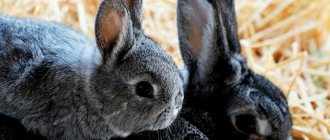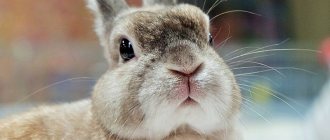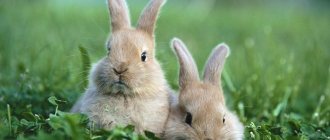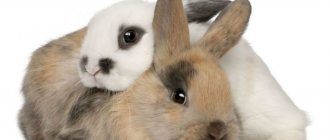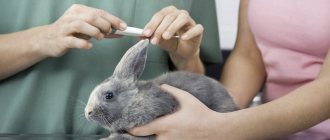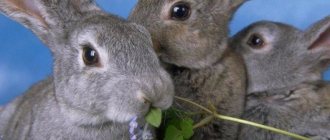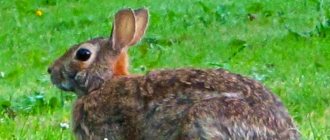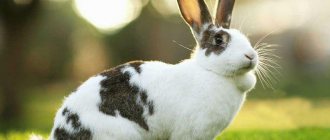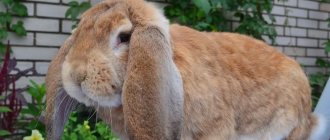1.1.Life expectancy of rabbits
So, in the wild, the average life expectancy of a fluffy is 2 - 3 years, and then only under a successful combination of circumstances. The conditions in which rabbits are kept directly determine how many years they will live.
Predators, diseases, and bad weather kill many animals at a young age. Pets that are bred for meat and skins also do not die a natural death. At 1 - 2 years they are released for slaughter, with the exception of breeding individuals - a good producer lives 3 - 4 years.
Decorative rabbits are more fortunate in this regard. In comfortable conditions, long-eared animals will be your faithful friends for 7-10 years, and some of them will be able to celebrate their 12-13th birthday. But, as practice shows, pets can live even longer - the record holder died at the age of 19.
1.2.Feeding of a decorative rabbit
There should always be food in the enclosure of decorative rabbits. Hunger is contraindicated for these animals, since digested food moves through the intestines only at the expense of newly received food.
If there is a break in feeding, excessive fermentation and rotting of the feces will begin in the feces (rabbits have special intestinal peristalsis). As a result, the animal will suffer from abdominal pain, bacteria will begin to multiply in highly fermented food, and the pet may die.
The feeding schedule of rabbits is not tied to specific hours. Hay, bark, branches of trees and shrubs are constantly in the enclosure, other food (greens, vegetables, fruits) is placed in the feeder twice a day - in the morning and in the afternoon. The drinking bowl is regularly replenished with fresh water.
Animals have twenty-eight teeth, including incisors, their length increases by 3 mm weekly. Solid foods (tree branches, green grass, vegetables and hay) constantly wear down the bone substance of growing teeth.
Animals should eat roughage to grind down their teeth every day in the quantity that nature dictates to them.
Rice. 1.2 Feeding decorative rabbits
Option 2
Rabbits are classified as mammals. They are divided into common and thick-tailed. The first rabbits appeared several thousand years ago in Mediterranean countries. Later they were tamed by people. The main difference between a rabbit is its fertility. They do not have a breeding season.
Outwardly they look cute. These are soft and warm animals. An adult rabbit reaches up to 50 centimeters in length. Weight varies from 500 grams to 2 kilograms. The fur is dense and fluffy. The color range is in a gradient from white to dark brown. Nature has blessed them with long ears and excellent hearing.
Fertility largely depends on feeding and maintenance conditions. Also from individual characteristics that can be inherited. On average, about 10 babies are born to rabbits. A female rabbit's pregnancy lasts 30-33 days. Intrauterine development occurs quickly. When babies are born, their weight is about 50–90 grams. Weight depends on the number of rabbits in the litter and the feeding of the mother.
Female rabbits feed their young for about 2 months. Rabbits born in winter and spring have good development indicators. They are distinguished by early maturity and growth. The fastest growth occurs at 4 months of age. At this time they reach the size of an adult rabbit. By 8 months growth ends.
Sexual reproduction occurs at 3-4 months of life. But it is better not to use this age for the reproduction of offspring, since the offspring will be born weak. The best age for breeding is 6 months. But it also all depends on the breed.
Rabbits can breed all year round. In summer, sexual interest appears every 6 days. Much less often in winter. Frequent childbirth can have a negative impact on the health of the female.
Rabbits are classified as mammals. They have a single-chamber stomach. It is significantly large in size. They can be applied to food up to 30 times per day. Juveniles eat more often than adults.
Many people raise rabbits for sale. They reproduce very quickly and require minimal costs. They can bring good income. The advantage of raising rabbits is considered to be a small investment of money. Does not require investment. You can start raising rabbits from scratch, starting from your own plot. If things get going, then such a home business can be taken to a high level. It’s also worth remembering about the healthy meat of rabbits. It is considered a dietary product.
1st, 2nd, 3rd, 4th grade. The world
The breeders have collected many interesting facts from the life of rabbits. Here are some of them:
Fluffy has a unique eye structure - he doesn’t have to turn his head to see his surroundings;
animals are most active in the morning and evening hours;
a rabbit has 4 claws on its hind legs, and 5 on its front legs;
only the animals’ paws sweat, so under the summer sun they quickly overheat;
your furry friend can move his ears independently of each other - this helps determine the direction of the sound source;
in most countries the rabbit's paw is considered a symbol of good luck;
in a minute the animal is able to make 120 chewing movements;
a rabbit can be trained to respond to its name;
if, upon your appearance, the long-eared animal rose on its paws, it means that it recognized you;
the pet distinguishes only green and red colors, as well as their shades;
some historians believe that the name of the country Spain was invented by the Phoenicians, and earlier it sounded like “ishpanim”, that is, “rabbit coast”;
a furry baby weighing 2 kg can drink the same amount of water as a 10 kg dog;
if you find yourself on an uninhabited island, you are likely to meet rabbits there, since ancient sailors specially resettled animals so that shipwrecked people would not be left without food;
Fluffy does not need to be bathed, because he carefully licks his fur 5 times a day, and the appearance of an unpleasant odor may indicate a disease;
if you have flea treatment or shampoo for cats and dogs, do not treat rabbits with it - they can be poisoned;
pets remember the location of furniture in the house;
whiskers in animals grow not only near the nose, but also around the circumference of the muzzle (the so-called whiskers, like in cats), helping to determine the distance to an obstacle and not bump into objects in the dark;
a rabbit can really die of fear - its heart already beats at a frequency of 130 - 325 beats per minute;
furry babies cannot live alone, so at home they find friends among people, dogs, cats and other pets;
the female spends 5 minutes a day feeding her children;
long-eared animals rub their chins against surrounding objects, leaving a secret with a specific smell and thereby marking the territory;
the female rabbit builds a nest from her own wool, plucked from her breast;
these are smart animals that can open the latch on their cage themselves, make noise as if by chance and wake up the owner in order to get food, run to the door at the sound of familiar steps;
the normal body temperature of a rabbit is 38 - 39°;
males reach puberty at 4 - 5 months, females at 5 - 8 months.
2.1.Running
Another interesting information is that the running speed of the eared animal can reach 55 km/h.
Rabbits even take part in obstacle course competitions. Of course, the speed of the hare is higher - 70 km/h, but the fact remains a fact.
The fluffy rabbit is motivated by treats, and he performs such tricks with pleasure. And if a predator chases your pet, it will give a greyhound a head start.
Types of rabbits, photos and names.
Modern classification within the hare family distinguishes several genera of rabbits, most of which are American varieties. Below are descriptions and photographs of some types:
- Wild rabbit , also known as the European rabbit (Oryctolagus cuniculus)
the only species of domesticated rabbit that gave birth to many modern breeds. This small animal grows in length up to 31-45 cm with a body weight of 1.3-2.5 kg. The ears of a rabbit are shorter than the skull and have a length of 6 to 7.2 cm. The back of a wild rabbit is brownish-gray in color, maybe with a reddish mark. A faded strip of light fur runs along the sides of the animal, forming a wide spot on the hips. The belly is white or light gray, the tips of the ears are trimmed with black, the tip of the tail is black or gray, the bottom of the tail is white, the top is black-brown. In 3-5% of cases, rabbits are black, light gray, white or motley in color. The main habitats of the rabbit are rugged bush landscapes: ravines, quarries, coastal cliffs - places with light, sandy soil, suitable for digging winding holes. Wild rabbits eat leaves and stems of plants; in fields and gardens they forage for cabbage, lettuce, carrots and grain crops. With the onset of cold weather, the main source of food becomes the bark and branches of trees and shrubs; in the absence of food, their own excrement. The wild rabbit is spread over all continents except Antarctica and Asia. In Russia it can be found in the North Caucasus and the Azov region.
Photo credit: JJ Harrison
Photo credit: JJ Harrison
- Water rabbit (Sylvilagus aquaticus)
It swims well, which is how it got its name. The large animal grows in length up to 45-55 cm and weighs from 1.6 to 2.7 kg. The overall color of a rabbit's fur ranges from red-brown to almost black, with only the throat, belly and underside of the tail being white and the eyes having a dark ring around them. The basis of nutrition consists of various herbs and grains, including reed. The water rabbit lives in swamps and other wet areas of the southern United States: from Texas to South Carolina.
Photo credit: Dave Welling
- Red rabbit (Pronolagus randensis)
a species of African rabbit that lives exclusively in mountainous areas. The red rabbit has a fairly large body with a length of 42 to 50 cm and large ears. The rabbit weighs about 2.3 kg. A distinctive feature of the species is the light silky fur of red-brown with gray color and a large brick-colored tail with a black tip. These animals feed on insects and all kinds of vegetation: cereals, leaves, fruits. The largest population of animals lives in the rocky mountains of Africa: in Zimbabwe and Namibia.
- Idaho rabbit , also known as the pygmy rabbit (Brachylagus idahoensis)
the smallest rabbit in the world, it is distinguished by very short hind legs, and therefore does not have the ability to move by jumping, like other hares. Representatives of the species grow in length from 22 to 28 cm with a body weight from 250 to 450 g. The fur of the rabbit on the back is yellow-brown in color, the belly and paws are lighter. The Idaho rabbit is a typical representative of the fauna of the northwestern states of the United States (Idaho, Montana, Wyoming), where it usually lives in thickets of three-toothed sagebrush, which is its main source of food.
Photo credit: Beth Waterbury
Photo by: Michael Durham
- Nuttala rabbit (Sylvilagus nuttallii)
very similar to the American snowshoe hare, but differs in its smaller size and a characteristic brown spot on the back of the head. The body length of the mammal is 33-40 cm, the tail length is 2.5-5 cm. Representatives of the species have very long hind legs with large feet covered with long thick hair. The main fur color is light brown. The rabbit feeds on grasses such as wheatgrass, bluegrass and quinoa, with bark and plant branches added in winter. The Nuttala rabbit lives in mountainous regions of Canada and the United States (from Arizona to the Cascade Mountains).
Photo by: Robert Shantz
- California rabbit (Sylvilagus bachmani)
a large animal, growing up to 50 cm in length. The weight of a rabbit is about 4 kg. A distinctive feature is the rabbit’s ability to successfully climb low trees and bushes. The animal feeds on various herbs, berries and leaves of thicket vegetation (for example, raspberries), in which it prefers to live. The species' range extends across Central America along the Pacific coast from Colombia in the south to the Sierra Nevada in the east.
Photo by: Barry Langdon-Lassagne
- Steppe rabbit (Sylvilagus audubonii)
Outwardly it resembles the European wild rabbit, but differs in much larger ears with a vertical set. The size of rabbits ranges from 33 to 43 cm with a weight of about 1.5 kg, and the length of the ears reaches 10 cm. The color of the back is grayish-brown, the belly is almost white. Steppe rabbits eat a variety of grains, grasses, and cacti that grow in their favorite habitat - the desert grasslands of the American southwest. The steppe rabbit can also be found in more humid areas - pine-juniper forests. The species' range extends across western North America through Texas to Central Mexico.
Photo by: Greg Lasley
- Tailless rabbit , also known as volcano rabbit or teporingo (Romerolagus diazi)
one of the smallest rabbits that lives only in the mountains of Central Mexico near the Popocatepetl and Iztaccihuatl volcanoes. Its length does not exceed 32 cm, and its weight barely reaches 600 g. The animal is distinguished by compact, rounded ears and such a small tail that it is impossible to see it. Tailless rabbits live in pine forests located high in the mountains, often up to 4.2 km above sea level. The main food of a rabbit is herbaceous vegetation. The biotopes of these animals cover forests, steppes, meadows, pastures, deserts, as well as wet, marshy lands.
Photo by: Jaime Rojo
2.2. Do rabbits make sounds?
Rabbits practically do not make sounds, although they can do it. If you hear something similar to purring or quiet clicking of teeth from your furry friend, know that this is how he expresses pleasure. Moreover, this is observed only among domesticated animals, that is, it is intended for humans (like the purring of a cat).
Loud sounds indicate that the pet is in pain. Decorative animals sometimes mumble. Similar rumbling notes are produced by the female rabbit while feeding her young.
If a rabbit quietly whines, growls or grunts, he is unhappy or irritated. Loud grinding of teeth indicates aggression or fear.
For example, rabbits really do not like to bathe; it is stressful for them. Therefore, during this procedure they can make similar sounds.
In general, an experienced breeder can easily determine the mood of a rabbit by the sounds it makes.
Rabbit breeding
Rabbits are considered one of the most prolific mammals and can breed all year round, during which time one female rabbit produces 3 to 5 litters. Rabbits reach sexual maturity at the age of 5-6 months, so rabbits born at the beginning of the year are already able to reproduce in the summer. Rabbits are polygamous animals, although some individuals are monogamous, and the males live in the territory of a particular female rabbit.
Rabbits' gestation period lasts from 28 to 40 days, and litters can range from 2 to 12 young, although 4 to 7 are common. The largest litter recorded is 24 rabbits.
American rabbits build nests on the ground; burrowing females make a nest underground, lining the bottom with fluff combed from their bellies.
Newborn rabbits usually weigh 40-50 grams and mature on the 10th day, and on the 25th day they are completely ready for independent life, although they are fed with mother’s milk for another week.
Starting from 3-4 weeks of life, little rabbits begin to eat food in addition to their mother's milk.
Despite caring for the offspring, many females are ready to mate within a few hours after giving birth.
In 60% of pregnancies, the embryos are resorbed, but on average, one female rabbit increases the overall population by 20-30 rabbits per year.
Blog about rabbits - the most interesting and useful for beginners
x
Check Also
To prevent their paws from freezing: rules for winter care of Indo-ducks The Indo-duck, or as it should be correctly called, the musky duck, comes from South America. Therefore, it is easy to guess that the bird is heat-loving and does not tolerate our harsh winters very well.
How to make feed for laying hens yourself? Every poultry farmer faces a dilemma: buy poultry feed or make it yourself? Often many factors influence the solution to this issue.
How to keep and raise broilers at home As you know, broilers are called chickens exclusively of meat breeds. That is, such chickens very rarely live to the point of egg production and are kept exclusively for meat.
Rabbit manure as a fertilizer: all about its use in the garden Rabbits are useful and highly productive animals. These animals not only go for meat and skins, but also produce rabbit manure, which is used as fertilizer in the garden.
We build a chicken feeder from different materials. This article presents several ways to build chicken feeders with your own hands, as well as photos and original ideas.
A constant companion of city residents is the rock pigeon. The most common inhabitant of city parks and streets is the rock pigeon. What kind of life does this breed have and what is it famous for, let's find out together! It belongs to the sedentary birds that live and winter in one area, rarely going in search of warmth.
Rare and beautiful high-flying Kursk tumblers Today there are many breeds of pigeons, but some of them are especially rare and beautiful. These are the Kursk Tumbler pigeons.
Why did the quails stop laying eggs at the same time? Good day. My name is Vladimir and my problem is that the quails stopped laying eggs at the same time.
Can chickens wheeze and sneeze from eating slugs? Hello! My chickens started wheezing and sneezing a lot. Snoring sounds like there is water stuck in your throat. We have a lot of slugs and the chickens eat them with pleasure.
Features of feeding geese in winter In warm seasons, there are no problems with feeding geese. During this period, they feed heavily on green food, which they find in the pasture.
Paralysis of the limbs of chickens and chickens: what to do? Those who keep chickens or are associated with veterinary medicine are well aware that such a thing as paralysis of the limbs in chickens can be caused by various ailments.
Report about rabbits. Interesting facts about rabbits. Do you know that…
1. Rabbits are not rodents, they belong to the family Lagomorpha.
They are not included in the group of rodent mammals because they have an additional pair of incisors, and there are other skeletal features.
2. Rabbits and rodents like hamsters and rats have a common ancestor that lived many millions of years ago. However, rabbits still do not belong to rodents.
3.Rabbits are often confused with hares. But there are many differences between these animals, despite the fact that they are relatives in the biological sense.
4. Rabbits in general are not highly intelligent, but nature has perfectly adapted them to survival.
5. Rabbits have successfully survived in the wild for many thousands of years of evolution, despite the fact that all predators larger than them willingly feed on them.
6. North America is home to more than 50% of all rabbits in the world.
7. Rabbits reproduce so quickly that they successfully occupy vast habitats, and many people also keep them as pets. And we're not just talking about farmers - some breeds of rabbits are popular as pets.
SILVER RABBIT
8. Despite the existence of more than 150 rabbit colors, they have only five different eye colors: brown, blue-gray, blue, pink and merle.
9. Rabbits actually have many more teeth than it seems at first glance - as many as 28.
10. There are about 17 thousand taste buds on the rabbit tongue.
11.They chew very quickly. When a rabbit feeds, its jaw makes an average of two chewing movements per second, and it can chew like this for a very long time without getting tired.
12.Nature has adapted rabbits' eyes to have excellent visibility so that they can always see a sneaking predator. So, rabbits even see what is happening behind them without turning their heads.
13. A hare can reach a running speed of 72 km/h, but a rabbit can only reach 56 km/h.
14. All 16 species of American rabbits live in forests and swamps and do not dig holes for themselves. In addition, they are excellent at climbing trees.
15. Outside of North America, all rabbits live exclusively in burrows and do not know how to climb trees.
16. Wild European rabbits dig deep and branched burrows, which sometimes unite into entire underground cities.
17.Rabbits are social animals, that is, in the wild they live in groups. This distinguishes them from hares, who exist more alone.
18.Only American rabbits can live alone, while all other species usually live in groups.
19. All types of rabbits, except one, live in underground burrows. This distinguishes them from hares, which build nests on the surface.
20. Rabbits used to be specially released on deserted islands so that shipwrecked people would have a source of food before they were rescued.
RABBIT - PYGMEY
21. The smallest breed of rabbits is called Little Idaho or pygmy rabbit. The maximum weight of an adult individual reaches only 450 grams, and the length ranges from 22 to 35 centimeters.
22. A rabbit has 18 claws: 4 on its hind legs and 5 on its front legs.
23. A female rabbit usually feeds her babies for about 5 minutes a day.
24. Rabbits can snore. Not all rabbits snore, but some do it with great pleasure.
25. Rabbits are very quiet animals, but they are not dumb. They mumble, hiss, squeak, and the male makes a short but quite loud sound immediately after the act of mating.
26. A two-kilogram rabbit can drink as much water as a ten-kilogram dog.
27. In summer, male rabbits can become sterile; reproductive function is restored with the onset of cool weather.
28. Introduced to Australia, rabbits proliferated so much on the territory of this continent that they began to pose a threat to the entire Australian ecosystem. To contain their spread, the government of this country even had to erect a special fence around areas teeming with rabbits.
29. In the Australian state of Queensland, it is legally prohibited to keep rabbits, even ornamental breeds. Violators face a fine of 30 thousand Australian dollars.
30. Rabbits are most active at dawn and dusk.
31. As you know, rabbits are good jumpers. Rabbits easily jump to a height of a meter and a half.
What types of rabbits are there?
Loading …
Rabbits of different breeds differ from each other. All breeds of domestic rabbits are divided into four large areas (depending on the type of products obtained from them):
- meat breeds;
- meat-skin;
- fur;
- downy
The main product obtained from these animals is rabbit meat - tasty dietary rabbit meat.
Rabbit breeding and rabbit breeds
The fur direction of rabbit breeding divides breeds into two more subgroups - normal-haired and short-haired. In our country, among the fur rabbit varieties, the most popular are: Russian ermine, Soviet chinchilla, silver, Vienna blue, black-brown, Soviet marder, veil-silver and others. Among the down rabbits, the white ones are the most popular.
The selection work of domestic rabbit breeders has led to the emergence of many domestic breeds that are well adapted to the difficult conditions of the Russian climate, and work to create new and improve existing rabbit species continues to this day.
The main breeding stock of these animals is concentrated in specialized breeding farms. Valuation data show that recently the structure of the composition of breeds on these breeding farms in percentage terms is as follows:
- white giant - approximately 50 percent of the country's total breeding stock;
- Soviet chinchilla – a little more than 25 percent;
- silver rabbit breed - approximately 10 percent;
- black and brown rabbits - about 6 percent;
- gray giant - approximately 4 percent;
- Vienna blues - around 3 percent;
- white downy rabbits – 1.5 percent.
These are the best breeds of rabbits for breeding in the Russian climate.
Regardless of the breed group, all rabbits need good care and adequate feeding. Even the largest and most productive animals, with an inadequate diet and poor living conditions, begin to degenerate and become smaller, while with proper nutrition and care, the quality characteristics of any rabbit variety begin to improve before our eyes.
In addition, experienced rabbit breeders note the danger of inbreeding (breeding), which leads to weak and non-viable offspring and can even lead to degeneration of animals. On the other hand, crossing the best productive breeds with each other produces strong and hardy hybrids that are not inferior to their ancestors in their productivity and surpass them in the degree of adaptability to various climatic conditions.
Describing all the existing breeds of rabbits is a thankless and time-consuming task. We will focus on just a few.
Rabbits in Australia
Another interesting fact about rabbit breeding is related to Australia. Rabbits appeared in this country thanks to an English traveler who founded a colony here. The rabbits were taken on a sea voyage for food, but the remaining ones were released into the wild in Australia. This led to the fact that, 80 years later, several million animals settled in the country, which multiplied at an incredible rate, although 1 million of them were shot every year.
At the beginning of the 20th century, a war of local residents began to exterminate the population. A 1,800,000-meter fence, shooting and poisoning, traps, hunting with ferrets, plowing up burrows and rabbit dwellings, strict control over farms - this is an incomplete list of measures to suppress the growth of rabbit groups. Thanks to tireless efforts, there are only about a hundred rabbit farms in Australia today.
Curious facts about rabbits are increasingly attracting people. Cute, funny animals often become pets. If you follow the rules of keeping, the rabbit will become a true friend of the family and will reveal many more interesting secrets about itself.
Rabbit breeds with photos and names
Today, in rabbit farming there are many breeds of rabbits, and animals are usually divided according to productivity into several groups depending on body weight and hair length. This classification identifies:
- Meat breeds,
- Fur (meat-skin) breeds,
- Downy breeds,
- Decorative and dwarf breeds.
There is also a classification of breeds by country. Below are just a few of the countries:
- German breeds of rabbits (German Motley Giant, Riesen, German Ram, German Ober);
- Soviet breeds of rabbits (Soviet Chinchilla, Soviet Marder, Russian Ermine, Gray Giant);
- French breeds of rabbits (Alaska, French Papillon, Champagne, French Ram, Rex, Chinchilla, Burgundy, Silver, Hotot, Harlequin);
- American breeds of rabbits (California, New Zealand White, American Sable, Palomino, Silver Fox, American Fluffy Fold).
Meat rabbits, photos and descriptions
Rabbits of meat breeds have fairly developed muscles, quickly fatten up and have a large slaughter weight. Young animals are ready to be sold for meat at the age of three to four months, and by six months the rabbit produces a good skin. Below is a description of some meat rabbit breeds with photographs:
- Burgundy rabbit
This is a breed developed in France. The animals have a slightly elongated body with a short neck and a fairly wide back, chest and croup. Burgundy rabbits grow very quickly and gain weight: at the age of four months, an individual reaches a weight of 4-4.5 kg. This precocity of the breed is highly valued by rabbit breeders who raise rabbits for meat.
- Silver rabbit
This is a French breed of rabbit. The animal is distinguished by a strong but harmonious constitution with developed muscles. Silver rabbits have a body length of 54-57 cm, as well as large and wide chests and croup. The weight of an adult rabbit is from 4.5 to 6.7 kg. A distinctive feature of the breed is its silvery-smoky shade of fur, which is evenly colored throughout the entire skin.
- Rabbit Flandre
Breeders are still arguing about the origin of the breed and have not come to a consensus about the country in which the Flanders appeared, although they are more inclined to Belgium. Rabbits of the Flanders breed are distinguished by their rather large dimensions: with a slightly elongated body length of 65-67 cm, the weight of the animal can reach 10-12 kg. The color of the thick fur varies from gray to gray-black, grayish-red, sand, silver or white. The Flanders rabbit is very prolific and easy to care for, grows quickly, and is therefore considered one of the best meat breeds.
- Rabbits Risen
This is a breed from Germany. Today, Risen rabbits are considered the largest among their long-eared counterparts. With a massive body length of 70-75 cm, some specimens reach a weight of 12-14 kg. The color of the skin can be very different: dark gray, sand, blue, black, brown-gray.
- California rabbit
This is a meat rabbit breed bred in the USA. The animals have a special color: the body is white, and the tail, nose, limbs and ears are black, chocolate and blue-gray. The massive, stocky body perfectly meets the criteria inherent in meat breeds. Rabbits of the Californian breed grow quickly: five-month-old animals weigh 3-3.7 kg, and at the age of six months they gain weight up to 6-7 kg.
Rabbits of fur (meat-skin) breeds, photos and descriptions
The animals are distinguished by a skin with thick fluffy fur, which is tanned and used for the production of fur products. At the same time, individuals have good performance in terms of weight gain and can be successfully bred for meat. The best rabbit breeds:
- Rabbit Gray Giant
a breed of rabbits bred in the USSR in the mid-50s. Rabbits of the Gray Giant breed have a very strong constitution. Body length reaches 66-68 cm with a weight of 5-7.5 kg. Thick and dense fur can be colored iron-gray or gray-golden with black markings. The belly is usually lighter than the back.
- Rabbit White Giant
a breed obtained as a result of the work of German and Belgian breeders. The length of the elongated body of the animal often exceeds 60 cm, and the weight of the rabbit varies from 4.6 to 6.5 kg. The fur is thick, silky and dense, pure white in color, without inclusions or shades, which is very valuable in the manufacture of fur products.
- New Zealand rabbit
this is an American breed. The animals are quite large: with a body length of 50-55 cm, the weight of an adult reaches 5 kg. The powerful constitution of the New Zealand breed of rabbits allows them to be raised for meat production, and the tanned skins with thick fur are in demand when sewing fur products. Based on color, the New Zealand rabbit is divided into pure white and red.
- Rabbit Rex
a French breed, individuals of which are distinguished by unusually soft and thick fur, looking like velvety velor, which is valued in fur production. The color of the skin can be of a wide variety of colors - from dark brown and white to bluish, gray or black. Rex rabbits have an elegant body structure. The body is elongated, no more than 55 cm long, the head is small, the chest and croup are quite narrow. The weight of an adult rabbit is 3-4.5 kg.
- Rabbit Butterfly
a breed that came from England. Individuals have an interesting coloration, expressed in symmetrically located spots of black, gray or brown on the overall white background of the skin. The body of the animal is distinguished by its power; with a body length of 55-60 cm, an adult weighs 4.5-4.8 kg. Rabbits of the Butterfly breed are used for raising for meat and for the sake of obtaining beautiful skins.
- Rabbit Chinchilla
French breed. The animals are distinguished by luxurious thick fur of a silver-gray color. In addition to its valuable skin, the breed is also bred for meat production: adult Chinchilla rabbits weigh 4 kg or more, with a body length of no more than 50 cm.
- Viennese blue rabbit
a breed bred by Austrian breeders. The elongated, strong and compact body does not exceed a length of 57 cm, the average weight of a rabbit is 4.5-5 kg, although some specimens gain weight of 6-7 kg. The fur is very thick, noble steel color with a slight blue tint, uniform, without inclusions of other shades. Dressed skins of Viennese Blue rabbits are successfully used in fur production to imitate the more valuable fur of other fur-bearing animals.
Downy breeds of rabbits, photos and descriptions
Rabbits of downy breeds are classified as long-haired, and their down perfectly competes with goat down in terms of heat resistance, strength and thickness.
- White fluffy bunny
a breed bred by Russian breeders. The animals have an average body length of 50-54 cm. The weight of an adult rabbit rarely exceeds 3.5-4.5 kg, but this breed is kept not for its meat, but for its valuable snow-white fluff. Its length in White Down rabbits reaches 9-11 cm, and from one animal you can get 700-900 grams of fluff per year.
- Angora down rabbit
The breed was developed in Turkey almost three centuries ago. Representatives of the breed are pure white, bluish-gray, black, fawn, brown and others in color. The Angora rabbit cannot boast of large sizes: with a body length of 44-47 cm, it rarely weighs more than 3 kg. The Angora down breed of rabbits has a distinctive feature in appearance: tufts on the ears. The silky down of a rabbit reaches a length of 23 cm; up to 1.5 kg of down can be collected from an animal in a year.
Photo by: Clevername
Breeds of decorative rabbits, photos and descriptions
The purpose of this group of rabbits is clear from the name: they are not bred for meat or skins, but are kept as pets. Decorative rabbits weigh from 3 to 5-9 kg. Among them are dwarf breeds - the weight of such a rabbit rarely exceeds 1.5-1.8 kg.
- Pygmy fox
This breed of rabbits was bred in Austria. A rather miniature decorative rabbit with a stocky body, weighing about 1.3 kg and a rather large head with closely spaced, rounded, protruding ears. All rabbits of the Dwarf Fox breed are long-haired, the fur can be colored in silver, yellow and bluish shades, but the most popular color is white or “Havana”.
- Dwarf fold sheep
a breed developed in Holland. The rabbit has a cylindrical body and a massive head with a fairly wide forehead. A distinctive feature of all individuals is drooping ears, the length of which reaches 25-28 cm. The weight of an ornamental rabbit varies between 1.5-2 kg. The fur is soft and silky, of various colors, and can be long or short.
- Rabbit ram
This is a breed from England. The animals are characterized by a fairly wide chest, as well as a massive head with a noticeable hump on the nose and hanging ears, reaching 50-60 cm in length. Despite the fact that sheep breed rabbits are quite large (with a body length of 70 cm they can weigh 8-9 kg), they are often kept as pets.
- Lionhead rabbit
A breed of decorative rabbits bred in Belgium. The head of these animals, covered with long hair, resembles the head of a lion. Long fur also covers the hind legs of the animal. The average weight of the animal is 1.7 kg. The rabbit's body is stocky, its ears are short and protruding. The fur color can be any, and among the main colors black, marder, agouti, white red-eyed, Siamese, fawn, Thuringian and orange stand out. These decorative rabbits are very easy to keep, they are clean and easy to train.
Rabbit representatives
- Idaho rabbit
- Swamp Rabbit
- Nuttalla Rabbit
- Steppe rabbit
- Florida rabbit.
Categories: Animals in alphabetical order Non-taxonomic groups Rabbits Paraphyletic groups
On this page there is material on the following topics:
Rabbit life cycle
All about the ordinary rabbit report
Report on the farm animal rabbit
Rabbit Message Outline
